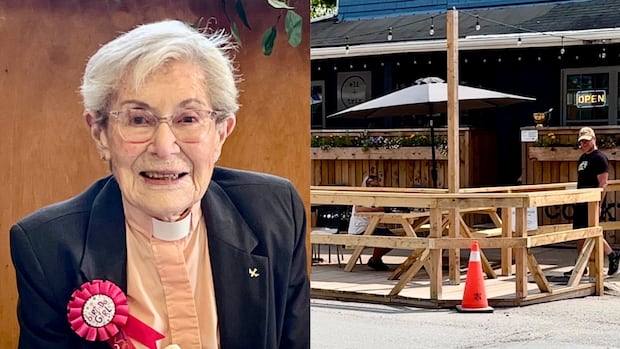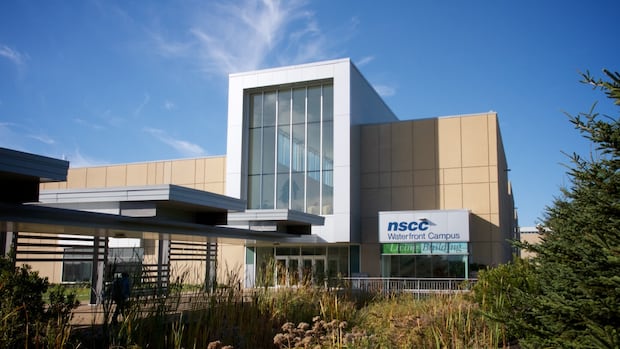Deputy prime minister, West Hants, N.S., mayor urging telecoms for better rural service

BROOKLYN, N.S. — Canada’s deputy prime minister is calling upon the country’s telecom providers to improve service following a deadly storm in Nova Scotia.
Chrystia Freeland visited West Hants July 27, touring some of the hardest hit areas in Ellershouse and St. Croix.
Aside from the sheer damage the flash flooding caused to infrastructure, the lack of cellular reception has been an ongoing issue, particularly in the area of Brooklyn, where searchers spent more than a week looking for four people who went missing during the storm. As of Aug. 1, the bodies of all four flood victims had been recovered.
During the height of the July 21-22 storm, several emergency alerts were issued about the weather. Not everyone received them. Other people couldn’t make or receive calls.
“It is really unacceptable for people not to be able to get emergency alerts,” said Freeland.
Alongside Kings-Hants MP Kody Blois, Freeland said she plans to address the issue “urgently” with François-Philippe Champagne, the federal minister of Innovation, Science and Industry. She said they will be urging the country’s telecommunications companies and the Canadian Radio-television and Telecommunications Commission (CRTC), which regulates them, to act.
“We really need to do a much better job — actually, they really need to do a much better job,” Freeland said.

That’s welcome news to West Hants Mayor Abraham Zebian, who said the dismal cellphone coverage has been a regular topic of discussion in council chambers since the municipalities of Windsor and West Hants amalgamated in 2020.
“It’s not just government, it’s big telecoms. They have a responsibility, and somebody has to be holding them to account because enough is enough,” Zebian said in an interview.
He participated in the tour with Freeland and Blois, and said every chance he got, he highlighted the issue.
“Look at your cellphone, look at my phone. I can’t make a call. If something was to happen, you’re on your own,” he said, as he described the tour.
“Every area we visited had no reception.”
The news conference with Freeland and Blois was held outside the temporary search command post at the Tidal Bore Farm Market. There was some cellular reception but that was due to signal boosters on site.
Zebian said every district in West Hants has, to some degree, cellular service problems.
“You go through St. Croix. No reception. You head out through Brooklyn, down the 236. No reception. The 215. No reception,” said Zebian. “Down in the Vaughans area, down in Lakelands — there’s a lot of zones (without service). It’s unbelievable.”
Long-standing issue
At the June 27 West Hants council meeting, District 3 Coun. Mark McLean requested the municipality write a letter to all cellphone carriers, in particular Bell Aliant, about the poor service in the region and request providers explore all options that would result in improved cellular service. After a 10-minute discussion on the issue, council instructed staff to draft a letter.
This was almost a month before the storm that highlighted the failings of the service.
At the meeting, McLean said “cellphone service has really gotten terrible” in the areas of Brooklyn, Ellershouse and Scotch Village since post-tropical storm Fiona.

Other councillors chimed in, noting poor reception in their districts as well.
“Not only do I agree with this, I’d also like to add … Upper Falmouth and Vaughan areas; it’s terrible,” said Coun. Ed Sherman, noting when he was canvassing for his seat on council, almost every second or third house he visited complained about cellular service.
Coun. Scott McLean, who represents District 2, said reception had “taken a nose-dive” in Cogmagun and Avondale. His primary concern was what would happen in an emergency.
“And where I have a major concern is with the 911 system,” said Scott McLean, noting that where there once was one or two bars of service, “now there’s no service. So, time is of the essence here to get something rolling because I feel it’s a major safety concern.”
Mark McLean’s report was endorsed by the municipality’s chief administrative officer Mark Phillips, who wrote he hoped that by making the carriers aware of the issue, it would spark a response.
“Bell Aliant has been attempting to secure land to place a cell coverage (tower) on in the Brooklyn area for almost 2.5 years. Several attempts have been made by Bell, with some assistance from my office, to secure lands owned by the province as well as any known private landowner with no success to date,” Phillips wrote in his report.
“Through this report and with greater awareness in the community, perhaps a landowner will come forward and offer to lease land for this purpose.”
Phillips noted Bell Aliant was willing to lease an area, about 100 feet by 100 feet in size, at market value.
Alert concerns
In the days following the torrential flooding West Hants experienced, there have been concerns shared over the emergency alert system used to notify residents of the dangerous conditions.
Some residents in the affected areas did not receive an alert.
On Aug. 2, when a news conference was held in Windsor announcing the discovery of the fourth flood victim, Blois said there are several lessons they can take away from the recent natural disaster.
“We can’t completely bubble wrap society but there are some things we have to do to be better. One is cell reception,” Blois said.

When he was touring the affected areas with Freeland, he couldn’t take a call — even though he was seven minutes away from Highway 101.
“When we start to see the impact of weather-related events, whether it’s fires, whether it’s hurricanes, whether it’s flash floods, we need to do better,” said Blois, noting he hopes to work with Champagne and Nova Scotia’s premier to improve cell service to rural communities.
“Emergency alerts, we’ve come a long way since Portapique but I think that there’s work that can be done in that domain.”
At a July 31 news conference, Cpl. Chris Marshall, a spokesperson with the Nova Scotia RCMP, was asked about the emergency alert system and how alerts were issued during the storm.
“When it comes to natural disasters, they are not police-led incidents,” said Marshall, noting that while the RCMP has access to the emergency alert system, it’s only used for police matters.
“Again, this is a natural disaster that requires a different type of alert than what we would have access to,” he said. “Any questions surrounding alerting or how the alerting process went that night would have to be referred to Nova Scotia Emergency Management Office.”
The first emergency alert came out at 3:06 a.m. on July 22, advising of extreme weather conditions and asking citizens to shelter in place.
At 5:47 a.m., West Hants Regional Municipality shared an emergency evacuation order for all residents of the St. Croix river system as the dam was at risk of breaching.
Later that evening, some businesses and houses in downtown Windsor, as well as some in Falmouth, were also asked to evacuate due to potential flooding near Lake Pisiquid.
On July 23, around 4 a.m., an emergency alert went out in error advising St. Croix area residents to evacuate again.
“That alarmed some people very early in the morning and that was an absolute technical error. It was somewhere in the software, as we understand, versus a human error,” Phillips said in an interview.
The mayor also heard of the glitch and said while it was upsetting for residents, he would rather an alert go out than not at all.
“Some people were worried and a little upset that the final alert went out in error … and it was an error,” said Zebian.
“I would tell people better safe than sorry,” he said, noting that while the emergency alert system needs some work, it is effective.
“People appreciate them … when the blaring goes off, it wakes you. It does its job but people need to get it and they need to get it reliably.”




